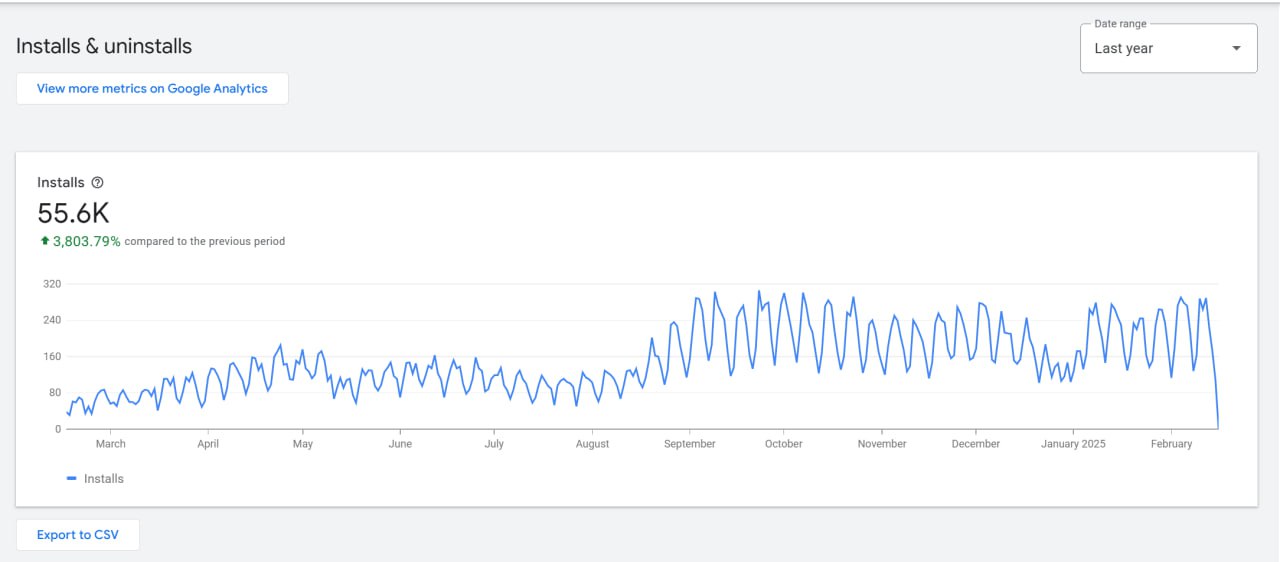How a Micro-Product Grows Over a Year: Lessons from the Field
Introduction
Launching a micro-product is one thing—keeping it growing and profitable over the long term is another challenge entirely. A product that sees early traction may stall without the right strategy, updates, and seasonal awareness.
Let’s take a real-world example - a Chrome extension launched just over a year ago. By analyzing its installation trends over time, we can see clear patterns that reveal valuable insights about seasonality, engagement cycles, and monetization opportunities.

1. Understanding Seasonality in Digital Products
📉 Why Product Growth Fluctuates Throughout the Year
- Sharp weekend drops – Typical for B2B and productivity tools, as professionals are less active outside workdays.
- Summer slowdowns – Vacation periods result in fewer new users and lower engagement.
- End-of-year revenue dips – Holidays (Christmas, New Year) lead to temporary declines in business-related activity.
- Post-holiday rebounds – January and February bring surges in new users as professionals restart their workflow.
Tip: Recognizing these cycles helps in adjusting marketing spend, launch timing, and promotional efforts for maximum impact.
2. Growth Peaks: The Best Seasons for Revenue
🔥 When Are the Best Months for Monetization?
- September-November (Back to Work Season) – Businesses and professionals seek new tools to improve productivity.
- January-February (New Year Reset) – Many professionals adopt new software as part of work resolutions.
- End-of-Fiscal Rush (November-December) – Companies with remaining budgets make last-minute purchases.
🚀 How to Leverage High-Revenue Periods
✅ Plan product launches & major updates in Q1 and Q3 for maximum traction.
✅ Increase ad spend and outreach in peak demand seasons.
✅ Run limited-time offers to convert free users into paying customers.
✅ Ensure server and support capacity to handle peak user growth efficiently.
Insight: The most successful SaaS and micro-products don’t just passively wait for growth—they align marketing and pricing strategies with these predictable revenue cycles.
3. Why Some Products Maintain Growth & Others Stall
The long-term success of a micro-product isn’t just about launching at the right time—it’s about continuous optimization and post-launch effort.
🏗️ Key Factors Behind Sustained Growth
- Strong initial positioning – Products that solve a clear pain point tend to scale faster.
- SEO-optimized listing – Proper Chrome Store/marketplace listing structure improves discoverability.
- Regular feature updates – Continuous product enhancements keep users engaged.
- Well-executed retention strategies – Email drip campaigns, in-app nudges, and value-driven updates increase long-term retention.
- User-driven improvements – Direct feedback from early adopters leads to the most impactful updates.
Example: The steady growth of Annotate PDF wasn’t just due to a good launch, but ongoing refinements based on user feedback and engagement trends.
4. Actionable Takeaways for Long-Term Micro-Product Success
✅ What You Can Do to Ensure Sustainable Growth
- Analyze and predict seasonality – Adjust marketing and development cycles accordingly.
- Invest in user engagement – Build long-term retention with personalized emails and product-led growth tactics.
- Optimize your pricing strategy – Introduce annual plans, limited-time deals, and regional pricing to maximize revenue.
- Monitor and iterate based on data – Growth isn’t static; constantly refine based on user insights and analytics.
Conclusion
A micro-product’s success isn’t just about its launch—it’s about how it evolves over time. The right combination of strategic updates, seasonal adjustments, and user-driven improvements can mean the difference between a product that stalls and one that thrives.
Understanding when, where, and how to focus resources ensures that your product continues to attract users, increase retention, and maximize revenue long after launch.
Want to optimize your product for long-term success?
agency.pizza specializes in SaaS growth strategies, retention planning, and product scaling.
Let’s build something sustainable together!



